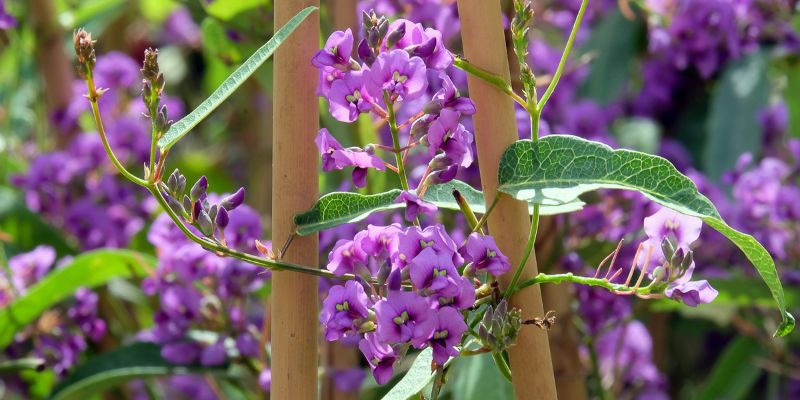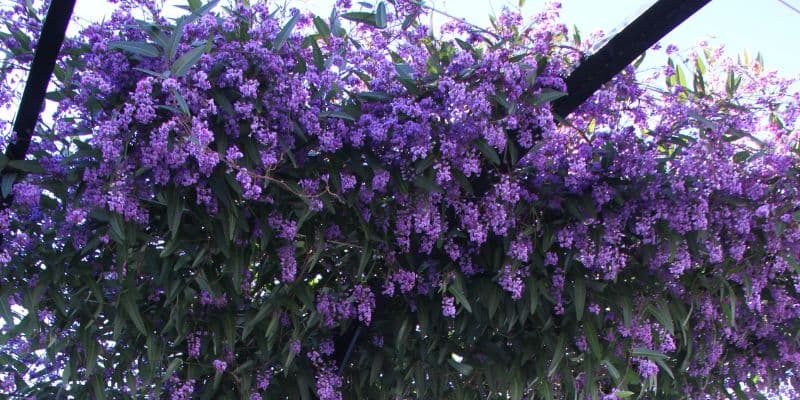Hardenbergia, also known as Australian lilac, is a vigorous climbing plant that produces magnificent violet, blue or white flowers (depending on variety), often from late winter through spring. If you already have an Hardenbergia and would like several in your garden, propagation of this plant is perfectly possible. In this tutorial, we will explore different methods to propagate this plant.
Why propagate Hardenbergia?
Propagating Hardenbergia allows you to obtain new young plants to fill more of your garden: cover a wall, create a green screen, or simply enjoy more flowers. You can also give this lovely plant to friends or swap it with other gardeners.
There are three main propagation methods: propagation by cuttings, layering and sowing.

Propagation by cuttings
The most common method to propagate Hardenbergia is propagation by cuttings. This involves taking a portion of stem from the parent plant and encouraging it to root.
When to propagate Hardenbergia by cuttings?
The best time to take cuttings of Australian lilac is in spring, between March and May, when the plant is in active growth. You can also propagate it in late summer (around mid‑August), when temperatures are still mild and stable.
How to take cuttings of Hardenbergia
1- Select a semi‑woody stem (i.e. one that grew last season, neither too old nor too young) about 10 to 15 cm long. Make sure it is healthy, free from disease and signs of weakness. Ideally, take 5 cuttings to maximise your chances of success.
2- Use a clean, sharp pruning shear to make a neat cut just below a node (where a leaf grows). Remove leaves from the lower part of the stem, leaving a few at the top.
3- Fill a pot with a light compost, such as seed compost or a mix of turf and sand or perlite. Moisturise this mix slightly before planting the cutting.
4- Facultative : Dip the base of the cutting into rooting hormone to increase your chances of success.
5- Make a hole in the substrate with a pencil, then place the cutting in it. Firm the substrate gently around the stem so it is stable.
6- Place a plastic cloche (a salad cloche or half a plastic bottle) or a clear bag, supported by stakes, over the pot to maintain high humidity. This will aid rooting. Ensure foliage does not touch the cloche to avoid mould formation.
7- Place the pot in a bright spot, but out of direct sunlight. Keep the substrate moist but not waterlogged. After 6 to 8 weeks, roots should begin to form. You can check by gently tugging the stem; if it resists, it is a good sign! Then remove the cloche.
8- The following season (autumn or spring), once the cutting has rooted well and new shoots appear, you can plant it into a larger pot or in your garden. Remember to choose a sunny, well‑drained planting spot.

Propagation by layering
Layering is another simple and effective method to propagate Hardenbergia. It involves burying part of a stem of the parent plant so it produces new roots while remaining attached to the main plant.
When to layer Hardenbergia?
Layering Australian lilac is ideally done in spring or early summer, when the plant is in active growth. During this period the stem will more easily develop roots while still attached to the parent plant.
How to layer Hardenbergia
1- Choose a low, long and flexible stem. It should be supple enough to be bent to the ground without breaking.
2- Make a small incision in the bark of the stem you will bury to stimulate root formation. Also remove leaves from the portion that will be in the soil.
3- Dig a small trench in the soil and bury part of the stem. Leave the tip of the stem above ground, with leaves intact. Use a stone or peg to hold the stem in place.
4- Keep the soil around the buried stem moist but not waterlogged. After a few months, roots should form under the soil. You can check by carefully digging around the stem. Once rooted, separate the new plant from the parent by cutting the stem and transplant it where desired.

Propagation by sowing
Propagation by sowing is a slower method, but it allows production of a large number of plants from the seeds of your Hardenbergia.
When to sow Hardenbergia?
Australian lilac is best sown in spring, when temperatures begin to warm and risk of frost has passed.
How to sow Hardenbergia
1- Seeds of Australian lilac have a hard coat. It is therefore recommended to soak them in warm water for 24 hours to ease germination.
2- Then fill pots with a light, well‑drained compost (ideally seed compost). Sow the seeds and cover with a thin layer of soil, then water gently.
3- Place the pots in a warm, bright spot but sheltered from direct sunlight. Keep the substrate slightly moist without excess.
4- When young plants have developed a few leaves and are strong enough, prick them out into larger pots or plant them directly in the ground.
Tips and tricks for success
- Patience : Whether by cuttings, layering or sowing, propagation of Hardenbergia requires patience. Some cuttings or seeds can take time to root or germinate.
- Monitor watering : This plant does not like to have its roots in water. Ensure soil is well drained and avoid overwatering, especially in winter.
- Protect young plants : Consider protecting young plants over winter until they are well established. An adult Hardenbergia dislikes severe cold and tolerates light frosts down to -4 °C maximum.
































Comments